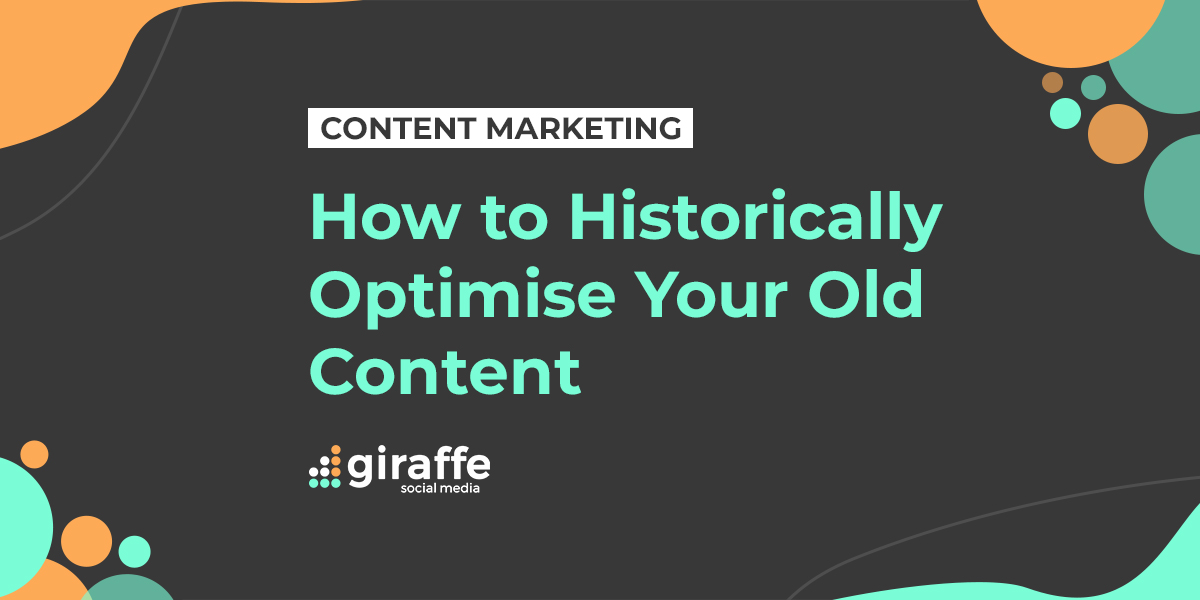Content marketing is one of the best branches of digital marketing because of the benefits it can provide to your brand.
However, there’s a new content marketing tactic that seems to be working in the digital world – historically optimising your old content.
What is Historical Optimisation?
Historical optimisation is repurposing your old content for the present. It’s finding an old article you think has value and putting a fresh spin on the subject matter. It has to be up-to-date and emit anything that is now irrelevant. You can historically optimise articles from a month ago, or even a few years ago, as long as they’ve been published on your website’s blog before. Historical optimisation can help the article generate ‘even more traffic and conversions than it already does.’
The idea behind historical optimisation is that you should stop creating new blog articles and start focusing on the content that already works by optimising it for relevancy. Content marketers get so caught up in producing articles as often as possible, that they often get caught in the mindset that more content equates to better results. Whereas, often it doesn’t. Underperforming content is useless, especially if it’s not generating any leads or clicks. However, according to The Daily Egg ‘optimising the content you already have can produce significant improvements in your content marketing effectiveness.’
Does Historical Optimisation Work?
HubSpot found that as a result of their continuous historical optimisation, they’ve been able to add value from past published content. They ‘more than doubled the number of monthly leads generated by the old posts’ and ‘increased the number of monthly organic search views of old posts they’ve optimised by an average of 106%’.
What Articles Should I Historically Optimise?
There are recommendations all over the internet about what articles are the best to optimise, but the consensus seems to be those that have just fallen short of driving a lot of traffic (maybe compared to your other pieces of content). Alexa suggest looking for articles that appear in a search at number eight to twenty when you look for them. They should also have a high click-through rate. This means your audience are already interested in the content, so when you optimise the article, it’ll appear in more recent, organic search results – a match made in digital heaven for click-through rates.
Alexa also recommend that you optimise content with high impressions and get that onto the first page of search results too. High impressions but low click-through rates are also great criteria for historical optimisation articles. These articles are already appearing in searches a lot. Therefore, all you have to do is improve the click-through rate by enhancing different aspects of the content to get people through to your blog and website.
How Do I Historical Optimise?
Make sure all your keywords are relevant and appearing in searches. You can use websites like Keyword Sheeter to see what words are being looked for and will work in your article. You should double check grammar and spelling and make sure you haven’t made an punctual mistakes. Also, use historical optimisation to improve readability and add sub-headings where necessary to structure the content more clearly. Readers are likely to skim-read most articles and headings allow your audience to find the information more quickly.
Update all your information to the current day. For example, your article may read ‘Instagram has five million users’ but be written in June 2011. In your new edit, you should research the current number of individuals using the social media platform and change or incorporate the new statistics into the sentence accordingly. For instance, ‘In 2011, Instagram had five million users, but in 2019, the number has risen to a staggering one billion active users a month!’
Ensure the article is a substantial amount of words. We recommend at least five hundred words for the articles to be deemed valuable by search engines. Update yourself on copyright laws and make sure all your images abide by them. You can use stock image sites to get pictures for your blog articles if you don’t have any. Also, add some external links that provide value to your article and include a couple of internal links too – these could be to a contact page or another piece of content.
Your business is likely to have evolved and changed since the first time the article was written, so make sure any images and graphics are updated to reflect this. You should also change the text to show your current brand voice and guidelines.
Optimise your article for SEO by ensuring the relevancy of your content and changing keywords, title tags, headers and parts of the body and the meta-description to enhance your search engine optimisation. You should also optimise the article to make it mobile-friendly too. More and more social media users are accessing platforms through their phones, and it’s definitely an audience that needs to be targeted.
Do not change the URL as it already has links and a rank on search engines. Creating a fresh one will mean you have to start all over again, rendering historical optimisation as useless.
Make sure you include a Call to Action, or at least update the old one you had to suit the new tone and message of the article. Your new content will be designed for a different audience, so your Call to Action should be directed that way too.
Update and then publish your ‘new’ article with an edit note if your content writer isn’t the same person that first published the article. You should then share the link to your blog to all your social media platforms too.
Why Content Marketing?
Historical optimisation and content marketing help to increase the visibility of your brand and improve awareness of your business. High quality blog articles create trust between you and your audience and establish you as a thought leader and expert in the industry. Content should always be educational, informative and interesting.
For more information on the benefits of content marketing or SEO, please get in contact with us today.





